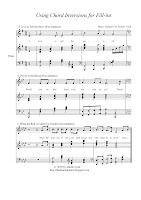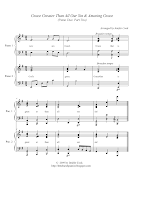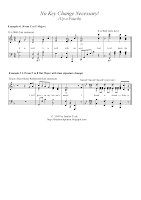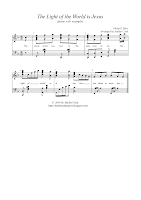Chord inversions work well for congregational singing because they add fullness to the accompaniment.For clarification: a chord inversion is nothing more than a
root chord out of order.
For example:
The
'C' root chord =
CEGThere are three notes in the
'C' chord...so....the notes in the
root chord can be scrambled (inverted) three different ways
and add such a variety in sound!
Root (
CEG) starting position
First inversion (
EGC)
Second inversion (
GCE)
Notice: the first note of each chord above....spells out the order
of the root chord.
Inversions create a more open tone compared to the close sound
of the root chord. Excessive use of the root chord produces a
cloudy tone. Learn to use more inversions!
Chord inversion fill-ins work best under the following conditions:*When the same chord lasts for at least two measures
(allows time for the inversions to fit)
*Militant style hymns such as the examples on today's image
*4/4 time is best
Keep in mind...in 4/4 time...only beats one and three are
accented.
Playing the same weight for each beat will create
unnecessaryhand tension and cause you to get bogged down in the mud;
creating a sluggish tempo.
All three examples on today's image are in 4/4 time.
The examples are geared to congregational accompaniment.
All three examples are on this one audio with a pause between
each one.
The audio below would be most beneficial if you view the music
while listening. You will hear how I accent beats one and three
for a more musical flow.
Warning!The constant movement of the chord inversionsmay cause disorientation at first :)Simply practice the chord inversions over and over before
implementing them in congregational accompaniment.http://www.box.net/shared/q8ltqay0y5













